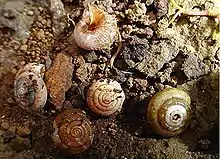Helicarionidae
Helicarionidae is a family of air-breathing land snails or semi-slugs, terrestrial pulmonate gastropod mollusks in the superfamily Helicarionoidea.[2]
| Helicarionidae | |
|---|---|
 | |
| Five worn shells of Erepta setiliris in the family Helicarionidae, at Réunion island | |
| Scientific classification | |
| Kingdom: | Animalia |
| Phylum: | Mollusca |
| Class: | Gastropoda |
| Subclass: | Heterobranchia |
| Superorder: | Eupulmonata |
| Order: | Stylommatophora |
| Suborder: | Helicina |
| Infraorder: | Limacoidei |
| Superfamily: | Helicarionoidea |
| Family: | Helicarionidae Bourguignat, 1877[1] |
Distribution
The distribution of Helicarionidae includes the eastern Palearctic, Malagasy, India, south-eastern Asia, Hawaii, and Australia.[3]
Anatomy
Species of snails within this family make and use love darts made of chitin.
In this family, the number of haploid chromosomes lies between 21 and 30 (according to the values in this table).[4]
Taxonomy
The following two subfamilies were recognized in the taxonomy of Bouchet & Rocroi (2005):[2]
- subfamily Helicarioninae Bourguignat, 1877 - synonyms: Pseudotrochatellinae A. J. Wagner, 1905;[5] Ereptinae Godwin-Austen, 1908;[6] Xestinae Gude & B. B. Woodward, 1921;[7] Sesarinae Thiele, 1931;[8] Nitoridae Iredale, 1937;[9] Epiglyptidae Iredale, 1944;[10] Gudeoconchidae Iredale, 1944[10]
- subfamily Durgellinae Godwin-Austen, 1888[11]
Genera
Genera within the family Helicarionidae include:
subfamily Helicarioninae
- Epiglypta Pilsbry, 1893[2]
- Erepta Albers, 1850[2]
- Gudeoconcha Iredale, 1914[2]
- Helicarion Férussac, 1821 - type genus of the family Helicarionidae[2]
- Kalidos Gude, 1911[16]
- Nitor Gude, 1911[2]
- Parmella H. Adams, 1867
- Plegma Gude, 1911
- Pseudotrochatella G. Nevill, 1881[2]
- Sesara Albers, 1860[2]
- Wilhelminaia Preston, 1913 [17]
- Xesta Albers, 1850[2]
subfamily Durgellinae
- tribe Durgellini
- Aenigmatoconcha C. Tumpeesuwan & S. Tumpeesuwan, 2017
- Austenia G. Nevill, 1878
- Cryptaustenia Cockerell, 1891
- Durgella Blanford, 1863 - type genus of the subfamily Durgellinae[2]
- Eurychlamys Godwin-Austen, 1899
- Holkeion Godwin-Austen, 1908
- Ibycus Heynemann, 1863
- Nesaecia Gude, 1911
- Pseudaustenia Cockerell, 1891
- Rasama Laidlaw, 1932
- Rhyssotopsis Ancey, 1887
- Rotungia Godwin-Austen, 1918
- Satiella Godwin-Austen, 1908[2]
- Sitala H. Adams, 1865[2]
- Sivella W.T. Blanford, 1863
- Sophina Benson, 1859[2]
- Teraia Solem, 1966
- tribe Girasiini
- Girasia Gray, 1855 - type genus of the tribe Girasiini[2]
subfamily ?
Cladogram
The following cladogram shows the phylogenic relationships of this family to other families within the limacoid clade:[3]
| limacoid clade |
| ||||||||||||||||||||||||||||||||||||||||||||||||||||||||||||||||||||||||||||||||||||||||||||||||||||||
References
- Bourguignat J. R. (1877). "Description de deux nouveaux genres algériens, suive d'une classification des families et des genres de Mollusques terrestres et fluviatiles du système européen". Bulletin de la Société des Sciences Physiques et Naturelles de Toulouse 3(1): 49-101. page 64.
- Bouchet, Philippe; Rocroi, Jean-Pierre; Frýda, Jiri; Hausdorf, Bernard; Ponder, Winston; Valdés, Ángel & Warén, Anders (2005). "Classification and nomenclator of gastropod families". Malacologia. Hackenheim, Germany: ConchBooks. 47 (1–2): 1–397. ISBN 3-925919-72-4. ISSN 0076-2997.
- Hausdorf B. (2000). "Biogeography of the Limacoidea sensu lato (Gastropoda: Stylommatophora): Vicariance Events and Long-Distance Dispersal". Journal of Biogeography 27(2): 379-390. doi:10.1046/j.1365-2699.2000.00403.x, JSTOR.
- G. M. Barker (2001). The Biology of Terrestrial Molluscs. CABI. p. 139. ISBN 978-0-85199-318-8.
- Wagner A. J. (1905). Denkschriften der Mathematisch-Naturwissenschaftlichen Klasse der Kaiserlichen Akademie der Wissenschaften 77: 365.
- Godwin-Austen H. H. (1908). "On the Animals of Genera and Species of Mascarene Land-Mollusca belonging to the family Zonitidae, collected by Monsieur E. Dupont". Annals and Magazine of Natural History (8)2: 422-436. 432. Plate 9-11.
- Gude G. P. L. K. & Woodward B. B. (1921). "On Helicella, Férussac". Proceedings of the Malacological Society of London 14(5-6): 174-190. page 185.
- Thiele (1931). Handbuch der systematischen Weichtierkunde 1(2): 620.
- Iredale T. (1937). The Australian Zoologist 9(1): 2.
- Iredale T. (1944). The Australian Zoologist 10(3): page 326 and page 328.
- Godwin-Austen H. H. (1888). Land and freshwater Mollusca of India 1(6): 253.
- Godwin-Austen H. H. (1900). In: Sykes Mollusca. In: Sharp (ed.) Fauna Hawaiiensis 2(4): 283.
- Blanford W. T. & Godwin-Austen H. H. (1908). The fauna of British India. Mollusca. Testacellidae and Zonitidae, page 283.
- Schileyko (2003). Treatise on Recent terrestrial pulmonate molluscs, part 10: 1319.
- Collinge (1902). The Journal of Malacology 9(3): 71, 73.
- Bank, R. (2017). Kalidos Gude, 1911. In: MolluscaBase (2017). Accessed through: World Register of Marine Species at http://www.marinespecies.org/aphia.php?p=taxdetails&id=996393 on 2017-11-05
- Ho Wai Hoong "A Review Of The Land-Snail Fauna Of Singapore" The Raffles Bulletin of Zoology 1995 43(1): 91-113
External links
| Wikispecies has information related to Helicarionidae. |
| Wikimedia Commons has media related to Helicarionidae. |